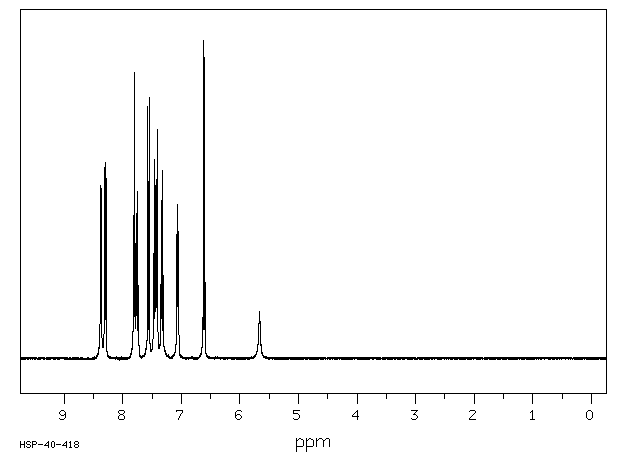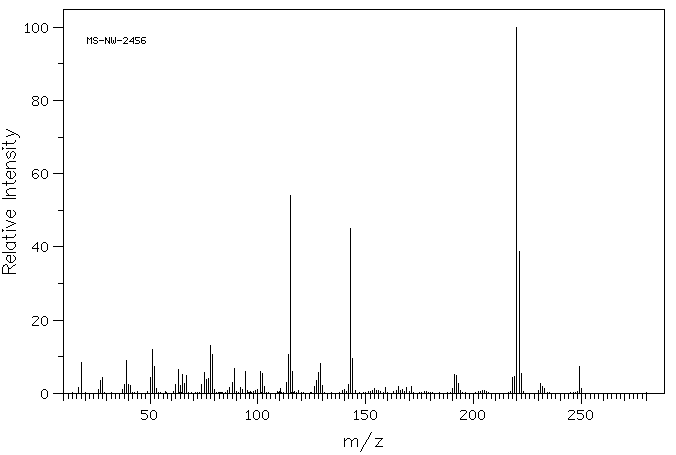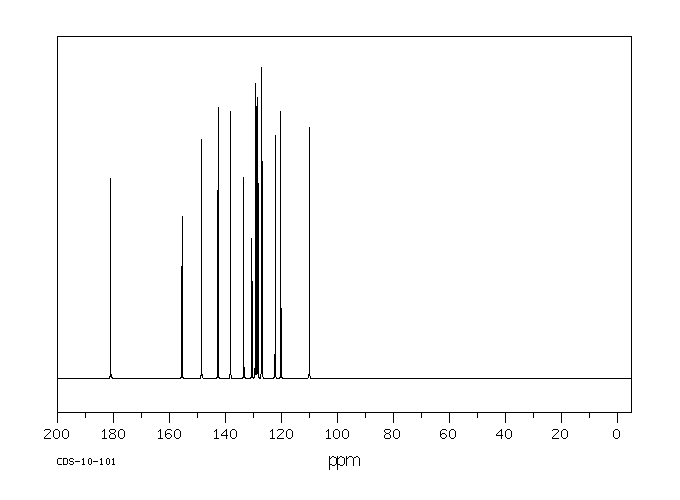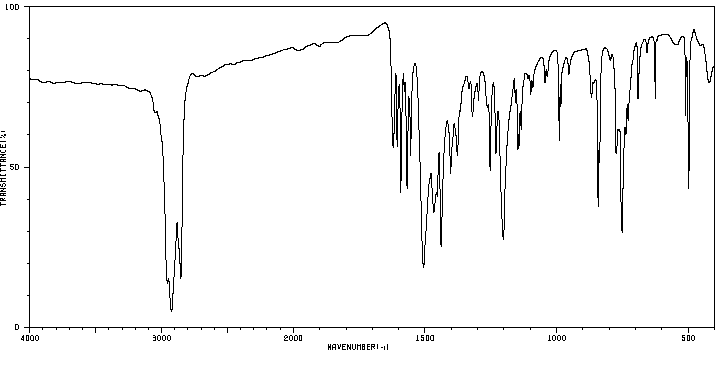1-(2-Pyridylazo)-2-naphthol | 85-85-8
中文名称
——
中文别名
——
英文名称
1-(2-Pyridylazo)-2-naphthol
英文别名
1-(pyridin-2-yl-azo)-2-naphthol;1-(2-pyridylazo)-naphtol-2;1-(2-pyridylazo)2-naphthol;1-(2'-Pyridylazo)-2-naphthol;1-(pyridin-2-yldiazenyl)naphthalen-2-ol;1-(2-pyridyl-azo)-2-naphthol
CAS
85-85-8
化学式
C15H11N3O
mdl
——
分子量
249.272
InChiKey
LLYOXZQVOKALCD-ISLYRVAYSA-N
BEILSTEIN
——
EINECS
——
-
物化性质
-
计算性质
-
ADMET
-
安全信息
-
SDS
-
制备方法与用途
-
上下游信息
-
文献信息
-
表征谱图
-
同类化合物
-
相关功能分类
-
相关结构分类
物化性质
-
熔点:138-141 °C (lit.)
-
沸点:392.37°C (rough estimate)
-
密度:1.1469 (rough estimate)
计算性质
-
辛醇/水分配系数(LogP):4.36
-
重原子数:19.0
-
可旋转键数:2.0
-
环数:3.0
-
sp3杂化的碳原子比例:0.0
-
拓扑面积:57.84
-
氢给体数:1.0
-
氢受体数:4.0
安全信息
-
TSCA:Yes
-
危险品标志:Xi
-
安全说明:S26,S36,S37/39
-
危险类别码:R36/37/38
-
WGK Germany:3
-
海关编码:29333999
-
危险品运输编号:NONH for all modes of transport
-
危险性防范说明:P261,P305+P351+P338
-
危险性描述:H302,H315,H319
SDS
制备方法与用途
用途
1-(2-吡啶偶氮)-2-萘酚是一种过渡金属指示剂。它不仅用于络合滴定法中,还作为萃取和分光光度法测定多种过渡金属的试剂。此外,该物质也是一种染料和代谢物。
化学性质1-(2-吡啶偶氮)-2-萘酚为橙红色无定形粉末,熔点为141℃。它溶于甲醇、乙醇、苯、醚、氯仿以及热稀碱液中,但不溶于水。其溶液在pH值超过12时呈粉红色,在弱酸性条件下则显橙红色,而在浓硫酸中会呈现紫色。与金属形成的络合物则呈现粉红色或红色。
用途该品主要用作络合指示剂。
生产方法1-(2-吡啶偶氮)-2-萘酚的制备过程如下:首先由2-氨基吡啶经重氮化处理后,与2-萘酚进行偶联反应。具体步骤为将无水乙醇与金属钠作用生成乙醇钠,再加入2-氨基吡啶的乙醇溶液,并通入亚硝酸乙酯蒸汽,在45至50℃条件下反应。反应结束后保温8小时,然后过滤出重氮盐并用乙醚洗涤。接着将此重氮盐加入到2-萘酚的乙醇溶液中,在同一温度下进行偶合反应6小时后过滤得到结晶体。最后,使用蒸馏水洗涤,并在乙醇中进行重结晶干燥即可获得成品。
反应信息
-
作为反应物:描述:参考文献:名称:A Simple Reduction Method of Azo-Compounds to Amines Using Fe Powder in the Presence of NH4Cl摘要:A series of azo-compounds were reduced to related aromatic amines in the presence of Fe powder and ammonium chloride. This one step protocol led to the formation of products in middle to high yields, especially when electron releasing substituted aromatic azo-compounds were reduced.DOI:10.1007/s00706-007-0633-2
-
作为产物:参考文献:名称:GORELIK, M. V.;RYBINOV, V. I.;GLADYSHEVA, T. X., ZH. OBSHCH. XIMII, 58,(1988) N0, S. 2360-2370摘要:DOI:
文献信息
-
Selective Complexation in Three Component Cocrystals Composed of Pyrogallol[4]arene and Fluorescent Probes Pyrene and 1-(2-Pyridylazo)-2-naphthol作者:Constance R. Pfeiffer、Drew A. Fowler、Jerry L. AtwoodDOI:10.1021/acs.cgd.5b00609日期:2015.8.5Cocrystals composed of a pyrogallol[4]arene molecule (one of C-propylpyrogallol[4]arene in ethanol and one of C-hexylpyrogallol[4]arene in isopropanol) and a pyrene molecule were crystallized and investigated with the aim to develop trends based on solvent and aliphatic tail length of the pyrogallol[4]arene. These new trends along with previously determined trends for the fluorescent probe 1-(2-pyridylazo)-2-naphthol (PAN), were then used to crystallize a cocrystal composed of C-hexylpyrogallol[4]arene and two fluorescent probes, pyrene and PAN. Within a two-component cocrystal of pyrene or PAN, the probe molecules are complexed in both the endo (inside the pyrogallol[4]arene bowl) and exo (outside the pyrogallol[4]arene bowl) positions. However, in the three component system, selective complexation of the probes is demonstrated whereby the PAN molecules prefer to be endo and the pyrene molecules occupy exo positions.
-
Azo compounds reducing formation and toxicity of amyloid beta aggregation intermediates申请人:Mdc Max-Delbrück-Centrum Für Molekulare Medizin Berlin - Buch公开号:EP2368558A1公开(公告)日:2011-09-28The present invention relates to compounds suitable as modulators of protein misfolding and/or protein aggregation. The compounds are particularly suitable as inhibitors of amyloid aggregate formation and/or modulators of amyloid surface properties, and/or as activators of degradation or reduction of amyloid aggregates.本发明涉及适用作蛋白质错误折叠和/或蛋白质聚集调节剂的化合物。这些化合物特别适用作淀粉样聚集物形成的抑制剂和/或淀粉样表面特性的调节剂,和/或作为淀粉样聚集物的降解或减少的激活剂。
-
Self-Assembled Biodegradable Nanoparticles for Medical and Biological Applications申请人:Jabbari Esmaiel公开号:US20100086607A1公开(公告)日:2010-04-08A method for forming a biodegradable composition that self-assembles into nanoparticles is provided. The method includes reacting N,N′-Disuccinimidyl carbonate with hydroxyl end-groups of poly(lactide-co-fumarate) to form a composition comprising succinimide-terminated poly(lactide-co-fumarate).
-
Dissymmetrical diazo compounds comprising 2-pyridinium group and a cationic or non-cationic linker, compositions comprising them, method for coloring, and device申请人:David Herve公开号:US20060149044A1公开(公告)日:2006-07-06Disclosed herein are dissymmetrical cationic diazo compounds comprising a 2-pyridinium group and a cationic or non-cationic linker. Also disclosed herein are dyeing compositions comprising such compounds as a direct dye in a medium appropriate for the dyeing of keratin fibers, a method for coloring keratin fibers comprising contacting the keratin fibers with such dyeing compositions, and a device comprising a plurality of compartments.
-
Method of making palladium nanoparticles申请人:KING SAUD UNIVERSITY公开号:US10016752B1公开(公告)日:2018-07-10The method of making palladium nanoparticles is a microwave thermolysis-based method of making palladium nanoparticles from a complex of palladium(II) acetate Pd(O2CCH3)2 (or Pd(OAc)2) and a ligand. The complex of palladium(II) acetate and the ligand is melted in oleic acid and dichloromethane to form a solution. The ligand is 1-(pyridin-2-yldiazenyl)naphthalen-2-ol (C15H11N3O), which has the structure: The solution is stirred for two hours under an inert argon atmosphere, and then irradiated with microwave radiation to produce palladium nanoparticles.
表征谱图
-
氢谱1HNMR
-
质谱MS
-
碳谱13CNMR
-
红外IR
-
拉曼Raman
-
峰位数据
-
峰位匹配
-
表征信息
同类化合物
(S)-溴烯醇内酯
(R)-3,3''-双([[1,1''-联苯]-4-基)-[1,1''-联萘]-2,2''-二醇
(3S,3aR)-2-(3-氯-4-氰基苯基)-3-环戊基-3,3a,4,5-四氢-2H-苯并[g]吲唑-7-羧酸
(3R,3’’R,4S,4’’S,11bS,11’’bS)-(+)-4,4’’-二叔丁基-4,4’’,5,5’’-四氢-3,3’’-联-3H-二萘酚[2,1-c:1’’,2’’-e]膦(S)-BINAPINE
(11bS)-2,6-双(3,5-二甲基苯基)-4-羟基-4-氧化物-萘并[2,1-d:1'',2''-f][1,3,2]二氧磷
(11bS)-2,6-双(3,5-二氯苯基)-4羟基-4-氧-二萘并[2,1-d:1'',2''-f][1,3,2]二氧磷杂七环
(11bR)-2,6-双[3,5-双(1,1-二甲基乙基)苯基]-4-羟基-4-氧化物-二萘并[2,1-d:1'',2''-f][1,3,2]二氧杂磷平
黄胺酸
马兜铃对酮
马休黄钠盐一水合物
马休黄
食品黄6号
食品红40铝盐色淀
飞龙掌血香豆醌
颜料黄101
颜料红70
颜料红63
颜料红53:3
颜料红5
颜料红48单钠盐
颜料红48:2
颜料红4
颜料红261
颜料红258
颜料红220
颜料红22
颜料红214
颜料红2
颜料红19
颜料红185
颜料红184
颜料红170
颜料红148
颜料红147
颜料红146
颜料红119
颜料红114
颜料红 9
颜料红 21
颜料橙7
颜料橙46
颜料橙38
颜料橙3
颜料橙22
颜料橙2
颜料橙17
颜料橙 5
颜料棕1
顺式-阿托伐醌-d5
雄甾烷-3,17-二酮










